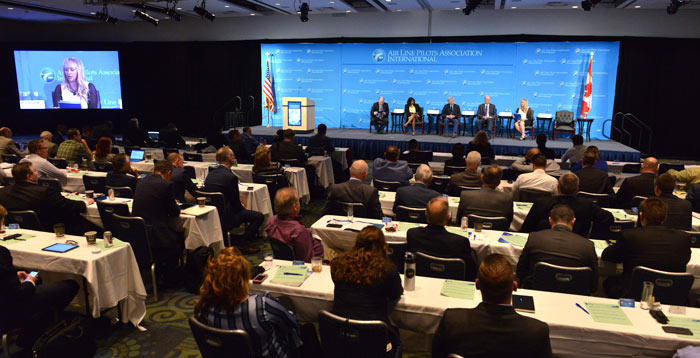Aviation Safety
By Capt. Steve Jangelis (Delta), Air Safety Organization Aviation Safety Chairman

ALPA’s annual Air Safety Forum highlights the Air Safety Organization’s role in advancing aviation safety and security.
Last year was the safest year on record in commercial air transportation. In the United States, we haven’t experienced a fatal passenger accident in more than nine years—thanks to the tremendous work of past and present ALPA pilot safety representatives and our industry and government partners. But as we all know, safety work is never truly done.
Commercial aviation today is at a crossroads, as our industry is retiring fleets of aircraft for new, fifth-generation airliners designed with the future of our profession in mind. These airliners are equipped to fly more safely and more efficiently in the airspace of tomorrow—NextGen.
NextGen is reshaping nearly everything we do as pilots, particularly in communication and navigation. Instead of instrument approach procedures based on an aging ground-based infrastructure, we’ll see more and more tailored procedures derived from performance-based navigation using GPS as aircraft equipage continues to evolve.
ALPA’s Air Safety Organization (ASO) is actively engaged in several working groups focused on developing new training processes and equipment to address early on any potential issues in NextGen implementation. In the area of communications, ALPA representatives have been vital to the successful introduction of datacomm at airports across the country by taking on the challenges and working with industry stakeholders to collaboratively integrate this new technology.
We’re also reaching out to our aircraft manufacturing partners such as Boeing and Airbus in the design phase of these next-generation aircraft to help ensure that the most important and effective safety feature of any aircraft—a well-trained, well-rested, experienced, and knowledgeable flight crew—isn’t overlooked and that the line-pilot perspective and experience is heard and considered.
As NextGen reshapes our airspace to allow for more efficient aircraft operations, we’re ever mindful of the challenge of safely integrating unmanned aircraft systems (UAS). While the present focus is their operations in and around airports, this focus will soon extend to the entire airspace infrastructure. While the government is concentrating on large UAS for defense and surveillance purposes and commercial and private operations focus on small UAS for delivery and recreational or hobby activities, we all need to work toward one goal: safely sharing airspace rather than segmenting it.
Furthermore, those who fly UAS are remote pilots, not simply operators. As such, the responsibilities of a pilot require adhering to training and certification standards, whether piloting a UAS for recreational or commercial purposes.
As for training airline pilots, we need to rethink our methods and adopt a human-centered performance approach over the established technology-driven, procedure-centered methodology. Science is showing us that this is an area in which we can see gains in improving the efficiency of our operations.
While there has been a push to install video cameras in cockpits to document operations, we remain steadfastly against any such initiative. We believe that this could weaken safety by causing a rush to judgment based on video instead of sound investigative principles. But we will continue to do everything we can to see that investigators have the voice and flight data they need in a timely manner.
We’ve recently witnessed a series of incremental victories in the carriage of dangerous goods—from the Pipeline and Hazardous Materials Safety Administration partnering with us to develop a test program to prevent undeclared dangerous goods from entering the air transportation stream to developing a proposed requirement to the International Civil Aviation Organization that airlines perform a risk assessment on the type and quantity of cargo carried on aircraft with an emphasis on dangerous goods and fire hazards.
Our successes are closely tied to the support our pilot representatives receive from ALPA’s expert professional staff. Whether it’s receiving guidance and advice from the Engineering & Air Safety or Government Affairs Departments, working with the Representation Department to enable the implementation of such programs as ASAP and FOQA, or sharing the news of a safety win through the Communications Department, we simply couldn’t achieve a fraction of our mission without the assistance of the Association’s unrivaled staff and resources. ALPA pilot representatives and staff stand ready to ensure that ALPA is at the forefront keeping our members and the traveling public safe.

